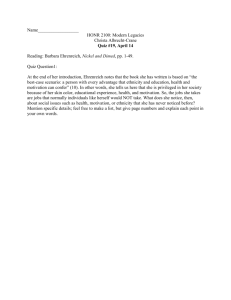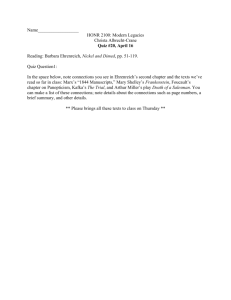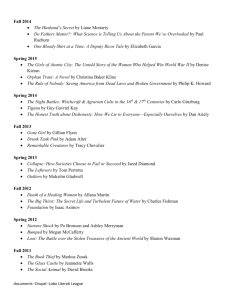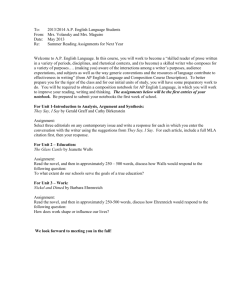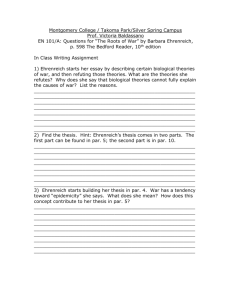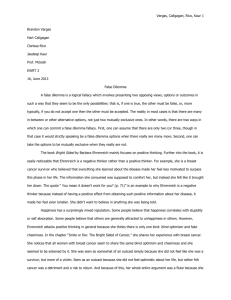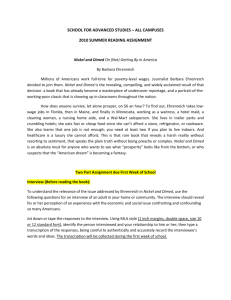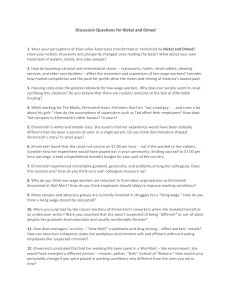File - Pablo Kidd Creations
advertisement
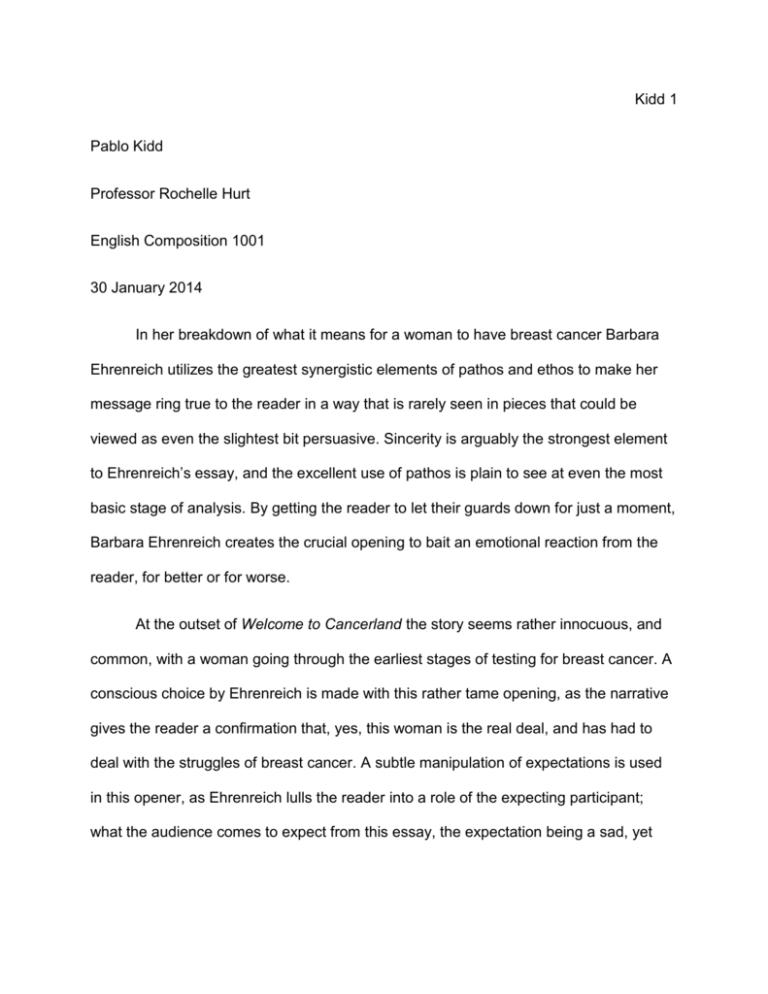
Kidd 1 Pablo Kidd Professor Rochelle Hurt English Composition 1001 30 January 2014 In her breakdown of what it means for a woman to have breast cancer Barbara Ehrenreich utilizes the greatest synergistic elements of pathos and ethos to make her message ring true to the reader in a way that is rarely seen in pieces that could be viewed as even the slightest bit persuasive. Sincerity is arguably the strongest element to Ehrenreich’s essay, and the excellent use of pathos is plain to see at even the most basic stage of analysis. By getting the reader to let their guards down for just a moment, Barbara Ehrenreich creates the crucial opening to bait an emotional reaction from the reader, for better or for worse. At the outset of Welcome to Cancerland the story seems rather innocuous, and common, with a woman going through the earliest stages of testing for breast cancer. A conscious choice by Ehrenreich is made with this rather tame opening, as the narrative gives the reader a confirmation that, yes, this woman is the real deal, and has had to deal with the struggles of breast cancer. A subtle manipulation of expectations is used in this opener, as Ehrenreich lulls the reader into a role of the expecting participant; what the audience comes to expect from this essay, the expectation being a sad, yet Kidd 2 well documented, and common reaction to breast cancer, is not at all where Ehrenreich leads them in the meat of the text. The transition from narrative to commentary is abrupt, and jarring to the reader in a fashion that is not only present with a shift in content, but also in intended message. One of the most moving sections of surprise commentary taking place is Ehrenreich sharing her views on what it means for a woman to be a breast cancer survivor, and more importantly, what it means for a woman to pass away due to breast cancer. “For those who cease to be survivors and join the more than 40,000 American women who succumb to breast cancer each year – again, no noun applies. They are said to have “lost their battle” and may be memorialized by photographs carried at races for the cure – our lost, brave sisters, our fallen soldiers. But in the overwhelmingly Darwinian culture that has grown up around breast cancer, martyrs count for little; it is the “survivors” who merit constant honor and acclaim. They, after all, offer living proof that expensive and painful treatments may in some cases actually work.” (Ehrenreich 6) The marrying of contextual shift and overall message takes place instantly, with Ehrenreich making sure to point out one of the biggest points of her essay by lambasting the helpless nature in which a woman with breast cancer is smothered to death by way of plastered smiles, routine, and hollow words; this deconstruction of the current social context surrounding breast cancer is succinct, and unapologetic, all while Kidd 3 simultaneously piercing the hearts of readers with an undeniably sincere, and agonizing voice of the human will to live: Yes, atheists pray in their foxholes—in this case, with a yearning new to me and sharp as lust, for a clean and honorable death by shark bite, lightning strike, sniper fire, car crash. Let me be hacked to death by a madman, is my silent supplication—anything but suffocation by the pink sticky sentiment embodied in that bear and oozing from the walls of the changing room. (Ehrenreich 1-2) A change of tone is thrust at the reader from that passage onwards, as the hohum narrative that has come to be expected is thrown out the window for the time being, and the reader is told “Welcome to Cancerland” (Ehrenreich 3). The pivotal shift in tone is so entrenched in personal experience that any accusations of insincerity would result in social repercussions akin to treason. The melding of ethos and pathos is the best skill in Ehrenreich’s toolkit, as she builds up the legitimacy of her experiences while simultaneously manipulating the reader into one of two mindsets: being offended by what’s being said, or being sympathetic to a woman who feels angry with the way a serious illness is written off as nothing more than a label, and a paper tiger of a cause. By creating this binary choice, Ehrenreich funnels the readers who may disagree with her into a cage that is constructed by modern culture. Should someone not agree with Ehrenreich’s points on breast cancer, publically sharing said disagreement would expose them to widespread criticism, as breast cancer is one of the more sensitive Kidd 4 medical issues to the general publc. The brilliance at which these emotions are drawn out is done with surgical precision, and Ehrenreich deserves a great deal of praise for being able to put forth such powerful arguments while remaining a pillar of sympathy, as she explains: “Now breast cancer has blossomed from wallflower to the most popular girl at the corporate charity prom. While AIDS goes begging and low-rent diseases like tuberculosis have no friends at all, breast cancer has been able to count on Revlon, Avon, Ford, Tiffany, Per1, Estée Lauder, Ralph Lauren, Lee Jeans, Saks Fifth Avenue, JC Penny, Boston Market, Wilson athletic gear—and I apologize to those I’ve omitted.” By pointing out how normalized the process of handling breast cancer in society has become, and the various mundane ways that citizens can impersonally help, Ehrenreich expertly points out the stark contrast between breast cancer and its societal counterpart. Breast cancer is an affliction that vastly changes someone’s life, and yet society has made it out to be a simple drive for positivity; it’s almost as if acknowledging the existence of doubt, anger, and fear is heresy. It’s not only the fact that she is upset, but that she can enlighten the reader as to which steps specifically in the process of dealing with cancer are the biggest offenders. This insight is valuable, as many accounts of dealing with cancer tend to glance over certain issues, preferring to go with the narrative that many people in society have come to expect. The confusion is explained briefly “…the infantilizing trope is a little harder to account for, and teddy Kidd 5 bears are not its only manifestation” (Ehrenreich 4), and thus one of the queer aspects of breast cancer society is opened for discussion. Ehrenreich has frankness to her writing voice, and it ties back into the believability, and sincerity of her words. The reader never feels that a secret agenda is being flung at them, and thus they are more willing to consider what Ehrenreich is saying. By leaving the message plain as day, with no strings attached so to speak, Ehrenreich gives herself some immunity to criticism, because what is there to criticize in personal thoughts, and feelings? Barbara Ehrenreich not only appeals to the average reader, but also to those who may take an academic eye to her text. By rooting the purpose of the essay into personal emotion, and getting thoughts across in a way that is done for no other reason than to inspire a new perspective on an existing situation, Ehrenreich throws a one-two punch to her critics, because to give criticism to her work is to give criticism to a cancer survivor’s feelings about having cancer—a major faux pas in the very society that Ehrenreich works to criticize in her essay. Whether intentional or not, Ehrenreich produced a finished essay that is both emotionally gripping, and simple to understand. More so than either of those elements is the rock solid defense Ehrenreich has to any potential critics, as the essay never strays beyond basic facts, and her own opinion on the state of society as it pertains to treating cancer. Ethos is the primary force in the opening narrative, and, by default, has a large injection of pathos due to the nature of the narrative’s content. Ehrenreich’s construction of her main argument is so expertly crafted that it leaves the audience Kidd 6 without any possible retort, and ultimately achieves her goal of making an example of the contrived sympathy machine that breast cancer culture as become. Once the reader is in the for the long haul, and their suspicious guard is disengaged, Ehrenreich ramps up the strong pathos, and logos argument in a pointedly honest manner; the end of the narrative occurs, the story is complete, and the reader is left with a comprehensive look at the cancer process, but more importantly, why it needs to change. Kidd 7 Works Cited Ehrenreich, Barbara. "Welcome to Cancerland." Harper's Magazine Nov. 2001: 1-11. Wikispaces.com. Web. 27 Jan. 2014. <http://wom101f2f.wikispaces.com/file/view/Cancerland.pdf>.
